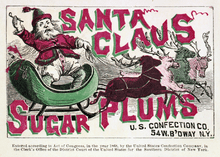Sugar plum
A sugar plum can be a piece of dragée or hard candy made of hardened sugar in a small round or oval shape.[1]
 Confection label, showing Santa Claus on sleigh with reindeer (1868) | |
| Type | Dragée or comfit |
|---|---|
"Plum" in the name of this confection does not always mean plum in the sense of the fruit of the same name, but commonly refers to small size and spherical or oval shape. Traditional sugar plums often contained no fruit, but were instead hardened sugar balls.[2] These hardened sugar balls were comfits, and often surrounded a seed, nut, or spice.[3]
History
A cookbook from 1609, Delights for Ladies, describes boiling fruits with sugar as “the most kindly way to preserve plums.”[4] The term sugar plum was applied to a wide variety of candied fruits, nuts, and roots by the 16th century.[5]
The term sugar plum came into general usage in the 17th century. During that time, adding layers of sweet which give sugar plums and comfits their hard shell was done through a slow and labor-intensive process called panning. Before mechanization of the process, it often took several days, and thus the sugar plum was largely a luxury product. In fact, in the 18th century the word plum became British slang for a large pile of money[6] or a bribe.[7] However, by the 1860s manufacturers were using steam heat and mechanized rotating pans, and it was then available for mass consumption.[2]
Today, some candy manufacturers have taken "sugar plum" literally, creating plum-flavored, plum-shaped candies and marketing them as "sugar plum candy".
Another 21st-century take on the "sugar plum" instructs home cooks to combine dried fruits and almonds with honey and aromatic seeds (anise, fennel, caraway, cardamom), form this mixture into balls, then coat in sugar or shredded coconut.[8]
In popular culture
Sugar plums are widely associated with Christmas, through cultural phenomena such as the Sugar Plum Fairy in The Nutcracker (composed by Tchaikovsky, 1892), as well as the line "While visions of sugar plums danced in their heads," from Clement C. Moore's poem A Visit from St. Nicholas (1823), better known as "'Twas the Night Before Christmas".
Sugar plums have also gained widespread recognition through the poem "The Sugar Plum Tree" by Eugene Field. The poem begins "Have you ever heard of the Sugar-Plum Tree? 'Tis a marvel of great renown!"[9] "Sugar Plum" is also a 1971 jazz song by American jazz pianist Bill Evans, while Sugar Plum Fairies is a Norwegian folk and pop band formed in 2000.
References
- Ward, Artimas. The Grocer's Encyclopedia. New York: 1911.
- "Sugar Plums: They're Not What You Think They Are". The Atlantic. December 22, 2010.
- "Sugar Plums: What Are They, Anyway?". Huffington Post. 13 December 2012.
- Rude, Emelyn (December 21, 2016). "The History That Explains Those 'Visions of Sugarplums'". Time. Retrieved April 12, 2020.
- Richardson, Tim (2008). Sweets: A History of Candy. Bloomsbury.
- c1728: '...those even that had nothing at the Revolution had the reputation after of being worth one hundred, and others two hundred thousand pounds. The first sum was christened one plum, and the last, two...' Thomas, Earl of Ailesbury: Memoirs (1890) volume II, p.499
- "...sugar-plum makers are as numerous in the Parisian Lombard-street, as are the traffickers in douceurs of a more substantial character in its namesake in London." "New Year's Day In Paris," The Times [London, England] 1 January 1823, p.3.
- Brown, Alton (2009). "Sugarplums Recipe". Good Eats.
- The Sugar Plum Tree, by Eugene Field (from FirstScience Archived 2006-08-22 at the Wayback Machine).